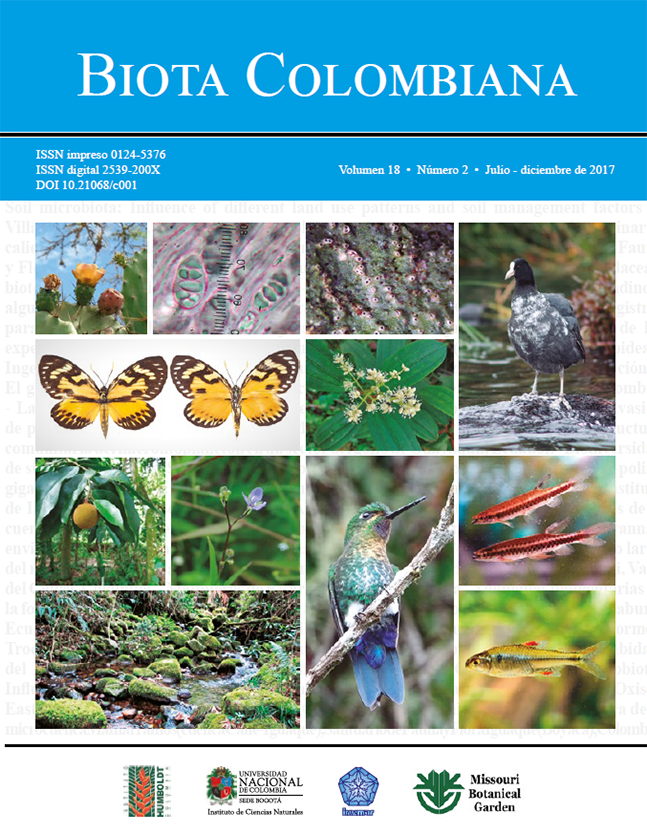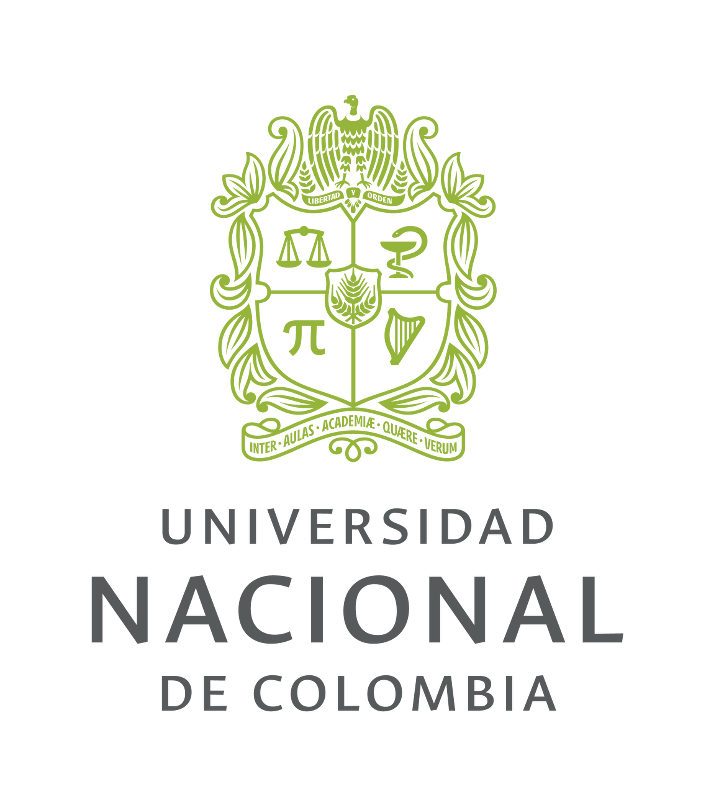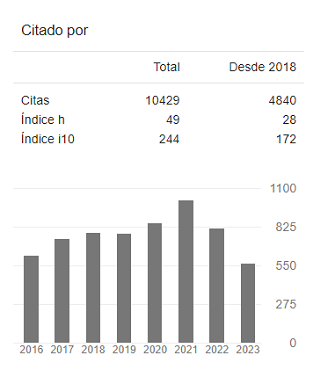Resumen (es):
Resumen (en):
Palabras clave:
Agroforestry system, Diversity, Microorganism, Monoculture (en)
Referencias
Alexander, M. 1982. Most Probable Number method for microbial populations. Pp. 815–820. En: Page, A. L., R. H. Miller and D. R. Keeney (Eds). Methods in Soil Analysis. Agronomy 9, part 2, 2nd edition. ASA, SSSA, Madson, WI.
Alvear, M. A., J. L. Rosas and F. B. Rouanet. 2005. Effects of three soil tillage systems on some biological activities in an Ultisol from southern Chile. Soil and Tillage Research 82: 195–202.
Balota, E. L., A. Colozzi-Filho, D. S. Andrade and R. P. Dick. 2003. Microbial biomass in soils under different tillage and crop rotation systems. Biology and Fertility of Soils 38 (1): 15–20.
Barreto, T. R., A. C. M. Da Silva, A. C. F. Soares and J. T. De Souza. 2008. Population densities and genetic diversity of actinomycetes associated to the rhizosphere of Theobroma cacao. Brazilian Journal of Microbiology 39 (3): 464-470.
Barrios, E. 2007. Soil biota, ecosystem services and land productivity. Ecological economics 64: 269-285
Bausenwein, U., A. Gattinger, U. Langer, A. Embcher, H. P. Hartmann, M. Sommer, J. C. Munch and M. Schloter. 2008. Exploring soil microbial communities and soil organic matter: Variability and interactions in arable soils under minimum tillage practice. Applied soil ecology 40: 67–77.
Beare, M. H. 1997. Fungal and bacterial pathways of organic matter decomposition and nitrogen mineralization in arable soil. Pp 37–70. En: Brussaard, L. and R. Ferrera- Cerrato (Eds). Soil Ecology in Sustainable Agricultural Systems. Lewis Publishers, Boca Raton, LA.
Brussaard, L., P. C. de Ruiter, G. G. Brown. 2007. Soil biodiversity for agricultural sustainability. Agriculture, Ecosystems and Environment 121: 233-244.
Ceja-Navarro, J. A., F. N. Rivera-Orduña, L. Patiño- Zúñiga, A. Vila-Sanjurjo, J. Crossa, B. Govaerts and L. Dendooven. 2010. Phylogenetic and multivariate analyses to determine the effects of different tillage and residue management practices on soil bacterial communities. Applied and Environmental Microbiology 76 (11): 3685–3691.
Da C Jesus, E., T. Marsh, J. Tiedje and F. Moreira. 2009. Changes in land use alter the structure of bacterial communities in Western Amazon soils. The International Society for Microbial Ecology Journal 3: 1004–1011
Delgado, H., G. H. Navas, C. R. Salamanca and A. Chacon. 2009. Legume improved fallows: a promissory agroecological alternative for allelopathic weed control in rice and maize crops in the Colombia Eastern Plains Agronomia Colombiana 27 (2): 227-235.
Di Rienzo, J. A., F. Casanoves, M. G. Balzarini, L. González, C. W. Robledo. 2010. InfoStat versión 2010. Grupo InfoStat, FCA, Universidad Nacional de Córdoba, Argentina. 18 p.
Gopalakrishnan, S., T. Watanabe, S. J. Pearse, O. Ito, Z. A. K. M. Hossain and G. V. Subbarao. 2009. Biological nitrification inhibition by Brachiaria humidicola roots varies with soil type and inhibits nitrifying bacteria, but not other major soil microorganisms. Soil Science Plant Nutrition 55 (5): 725-733.
Instituto Geográfico Agustín Codazzi – Igac. 2004. Estudio general de suelos y zonificación de tierras. Departamento del Meta. IGAC. 1 CD.
Jangid, K., M. A. Williams, A. J. Franzluebbers, J. S. Sanderlin, J. H. Reeves, M. B. Jenkins, D. M. Endale, D. C. Coleman and W. B. Whitman. 2008. Relative impacts of land-use, management intensity and fertilization upon soil microbial community structure in agricultural systems. Soil Biology Biochemestry 40: 2843-2853.
Kent, A. D. and E. W. Triplett. 2002. Microbial communities and their interactions in soil and rhizosphere ecosystems. Annual Review of Microbiology 56: 211-236.
Lauber, C. L., K. S. Ramirez, Z. Aanderud, J. Lennon and N. Fierer. 2013. Temporal variability in soil microbial communities across land-use types. International Society for Microbial Ecology 7: 1641–1650.
Mathew, R. P., Y. Feng, L. Githinji, R. Ankumah and K. S. Balkcom. 2012. Impact of No-tillage and conventional tillage on soil microbial communities. Applied Environmental Soil Science: 10 p.
Muhammed, U. P. F. B., P. V. Sindhu and K. S. Gopal. 2015. Influence of mulches on rhizosphere microflora, yield and weed competition in okra (Abelmoschus esculentus (L.) Moench). Journal of Tropical Agriculture 53 (1): 70-74.
Notaro, K., E. V. de Medeiros, G. P. Duda, A. O. Silva. and P. M. De Moura. 2008. Agroforestry systems, nutrients in litter and microbial activity in soils cultivated with coffee at high altitude. Scientia Agricola 71 (2): 87-95.
Paudel, B. R., R. P. Udawatta, R. J. Kremer and S. H. Anderson. 2012. Soil quality indicator responses to row crop, grazed pasture, and agroforestry buffer management. Agroforestry Systems 84: 311-323.
Paul, E. A. and F. E. Clark. 1996. Soil Microbiology and Biochemistry, Academic Press, San Diego, California, USA. 340 p.
Perez, A., C. Perez y G. Cardona. 2015. Hongos solubilizadores de fosfatos en suelos arroceros de la Mojana Sucre, Colombia. Arroz 53 (458): 22-31.
Pii, Y., L. Borruso, L. Brusetti, C. Crecchio, S. Cesco and T. Mimmo. 2016. The interaction between iron nutrition, plant species and soil type shapes the rhizosphere microbiome. Plant Physiology and Biochemistry 99: 39-48.
Prevost-Boure, N. C., P. A. Maron, L. Ranjard, V. Nowak, E. Dufrenea, C. Damesina, K. Soudani and J-Ch. Lata. 2011. Seasonal dynamics of the bacterial community in forest soils under different quantities of leaf litter. Applied Soil Ecology 47 (1): 14–23.
Radhakrishnan, S. and M. J. Varadharajan. 2016. Status of microbial diversity in agroforestry systems in Tamil Nadu, India. Journal of Basic Microbiology 56 (6): 662- 669.
Reis, M. A., K. Luciene, A. M. Rodrigues and E. Nahas. 2007. Recovery of soil microbiological properties in a degraded area planted with Corymbia citriodora and Leucaena leucocephala. Scientia Agricola 64 (1): 8-72.
Roger-Estrade, J., C. Anger, M. Bertrand and G. Richard. 2010. Tillage and soil ecology: Partners for sustainable agriculture. Soil and Tillage Research 111: 33-40.
Sylvia, D., J. Fuhrmann, P. Hartel and D. Zuberer. 2005. Principles and Applications of Soil Microbiology. Pearson Education Inc. New Jersey. 517 p.
Smith, P. 2008. Land use change and soil organic carbon dynamics. Nutrient Cycle Agroecosystem 81: 169–178. Voříšková, J. and P. Baldrian. 2013. Fungal community on decomposing leaf litter undergoes rapid successional changes. International Society for Microbial Ecology Journal 7: 477–486.
Wagg, C., S. F. Bender, F. Widmer and M. G. A. Van der Heijden. 2014. Soil biodiversity and soil community composition determine ecosystem multifunctionality. Proceedings of the National Academy of Sciences of the United States of America 111: 5266–5270.
Whipps, J. M. 2001. Microbial interactions and biocontrol in the rhizosphere. The Journal of Experimental Botany 52 (90001): 487-511.
Cómo citar
Las obras publicadas en las revistas del Instituto de Investigación de Recursos Biológicos Alexander von Humboldt están sujetas a los siguientes términos, con relación al derecho de autor:
1. Los derechos patrimoniales de las obras publicadas tienen como titular al Instituto de Investigación de Recursos Biológicos Alexander von Humboldt. Los autores o las instituciones que elaboran el documento aceptan ceder los derechos patrimoniales al Instituto Humboldt con el envío de sus artículos, lo que permite –entre otras cosas– la reproducción, comunicación pública, difusión y divulgación de las obras.
2. Las obras de ediciones digitales se publican bajo una licencia de Creative Commons Colombia:
Esta obra está bajo una Licencia Creative Commons Atribución-NoComercial-SinDerivar 4.0 Internacional.
Atribución – No comercial – Sin Derivar: Esta licencia es la más restrictiva de las seis licencias principales, sólo permite que otros puedan descargar las obras y compartirlas con otras personas, siempre que se reconozca su autoría, pero no se pueden cambiar de ninguna manera ni se pueden utilizar comercialmente.
3. Los autores, al someter artículos al proceso editorial de las revistas editadas por el Instituto Humboldt, aceptan las disposiciones institucionales sobre derechos de autor y acceso abierto.
4. Todos los artículos recibidos serán sometidos a un software antiplagio. El sometimiento de un artículo a las revistas del Instituto Humboldt se entiende como la aceptación de la revisión para detectar posible plagio.
5. Las obras sometidas al proceso de edición de las revistas del Instituto Humboldt deben ser inéditas.


















